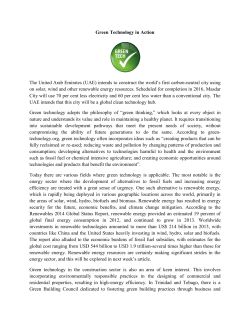
THEnergy study
THEnergy study Renewable Energy as a Leverage for Mining Companies in Negotiations with Utilities and Diesel Suppliers page 1 page 2 Content 1 Introduction .................................................................................................................................. 3 2 Methodology and design of the study.......................................................................................... 4 3 Discontent of mining companies with current energy providers ................................................. 5 3.1 High electricity and diesel prices ......................................................................................... 5 3.2 Power supply security .......................................................................................................... 6 3.3 Problems with connecting new mines to the grid ............................................................... 6 3.4 Structure of the utility sector .............................................................................................. 6 3.5 Mining companies focus more on energy ........................................................................... 7 4 Renewable energy as a leverage for mining companies in negotiations with current energy suppliers ............................................................................................................................................... 7 5 4.1 Renewable energy as an alternative for grid-connected mines .......................................... 8 4.2 Renewable energy as an alternative for off-grid mines....................................................... 8 4.3 Renewable energy in negotiations with current electricity and diesel suppliers ................ 9 Summary and outlook .................................................................................................................. 9 About Dr. Thomas Hillig Energy Consulting (THEnergy) ..................................................................... 11 Contact ............................................................................................................................................... 11 Legal Disclaimer .................................................................................................................................. 11 1 Introduction The business case for renewable energy projects in mining is very positive, especially for remote locations. Nevertheless, the number of solar and wind installations that have already been built does not reflect this fact. In February, two major announcements triggered huge interest in the topic of renewable energy and mining. Sandfire Resources have declared their intention to build a 10.6MW PV plant at their DeGrussa copper mine in Western Australia. The project would be approximately 10 times as big as the largest existing pilot solar-diesel hybrid power plant in the mining sector. Just a week later, South African-focused Sibanye Gold announced plans to build a 150MW solar plant to gain control over their energy costs, which make up 20% of the total costs. It can be expected that this is only one step in a major shift toward renewable energy application in the mining sector. A recent THEnergy study has already given more factors beyond pure cost advantages, which are in favor of renewable energy. Among the most important are communication potential of the page 3 sustainability effects, avoidance of stigmatization, and positioning as a progressive company.1 The study shows how renewable energy can contribute toward increasing the shareholder value of mining companies. The new study at hand focuses on a more operational topic. Expert interviews have shown that many mining companies are not very satisfied with their electricity providers — as well as diesel suppliers in the case of remote off-grid locations that are powered with diesel gensets. In negotiations with their current suppliers they can use renewable energy as an excellent leverage. PV plants can cut off a substantial part of the overall electricity bill, which is a threat to the current electricity suppliers, quite often large utilities that produce the vast majority of their electricity in central coal-, oil- or gasfired power plants in many mining locations. In general, renewable energy is especially for the profitable operation of coal and nuclear power plants a major threat, because the operating costs of wind and solar are almost equal to zero, which means that in spot electricity markets they are the preferred alternative. Utilities will struggle to a large extent in adapting their not very flexible coal and nuclear power plants to the new framework conditions. Many utilities still try to avoid the growth of renewable energy, because they see the danger of their business model. In contract negotiations this is a major threat potential for mining companies. The study analyzes where the discontent with their utilities and diesel providers comes from, and examines how mining companies can use renewable energy best in contract negotiations. 2 Methodology and design of the study Expert interviews are the methodological framework of the study.2 A total of 32 interviews was conducted with experts from the mining, financial/investment and renewable energy sectors. 1 THEnergy (2014). The influence of renewable energy on the market value of mining companies. Munich Germany. 2 Bogner, A., Littig, B., & Menz, W. (eds.) (2009). Interviewing Experts: Methodology and Practice. Basingstoke England: Palgrave Macmillan. page 4 Interviews with experts from the following sectors 5 mining financial / investment 8 19 renewables The interviews were conducted by phone or in personal meetings. The interviewed experts are from Australia, Africa, North and South America, and Europe. 3 Discontent of mining companies with current energy providers The expert interviews have shown that many mining companies are very dissatisfied with their energy suppliers. This is valid for both electrical utilities and diesel suppliers. The discontent is mainly based on the following factors: High electricity/diesel prices Unreliability High costs for new grid connections (not valid for diesel providers) Structure of the utility sector 3.1 High electricity and diesel prices Oil and coal prices have decreased considerably in the last 9 months. Nevertheless, so far this has not translated into equally low electricity or diesel prices for many mines. There is a variety of reasons for this. In case of long-term agreements these could be simply contractual reasons. Utilities and diesel providers are not willing to pass on the lower fuel prices as they are contractually not obliged to do so. Sometimes the expectation from the electricity or diesel off-takers is still that big, changes in fuel pricing are passed on to them. page 5 In addition, the oil spot market price does not always reflect the price of the suppliers of electricity or diesel. Sometimes they are also bound contractually or other factors such as transport, taxes and theft3 influence the purchase price of the suppliers immensely. Discontent comes also from the fact that the electricity prices have increased considerably over the last decades. For many mining companies this is particularly critical, given that the electricity demand normally increases during the lifetime of a mine. The mine has to reach deeper in order to exploit the minerals and metals. 3.2 Power supply security Mainly, grid-connected mines in Africa and South America complain about an unreliable electricity supply. Power outages and load shedding are major topics even in highly developed countries such as South Africa and Chile. Many mining processes are very sensitive to unpredicted cuts of the electricity supply. Especially in South Africa, power supply security is seen by many mining executives as an even bigger problem than the energy cost itself. Sibanye Gold communicated that the 150MWp solar power plant is the first step toward independence from the national utility. Some mining companies are not very satisfied with the diesel suppliers in general. Sometimes the only solution for avoiding diesel shortages is to store diesel directly at the mine, which represents additional costs and has a threat of theft. 3.3 Problems with connecting new mines to the grid In many countries, above all in Africa, the cost of connecting mines to the grid is very high and it takes the local grid operator a very long time to do so. For locations that are not very remote it very often costs several million dollars. Investment costs for new mines are already very high without these additional expenses. Costs of grid connection are CAPEX. Many mines are not used to high CAPEX for power generation. This is also a main obstacle for the quick diffusion of renewable energy in the mining sector. However, for renewable energies the financing is already much more sophisticated. There are several external investors who offer power purchase agreements or rental/leasing agreements for mining companies.4 It means that almost no initial investment cost has to be taken by the mine. 3.4 Structure of the utility sector 3 Theft is mainly relevant to diesel deliveries. See THEnergy (2014). Solar-diesel-hybrid power plants at mines: Opportunities for external investors. Munich Germany. 4 page 6 In many countries the utility sector is not very competitive; sometimes it is even a monopoly where the monopolist dictates the prices and conditions. Mainly, mining companies feel that they are not treated in a fair way by the utility companies. If competition is not high, normally customer orientation is not very distinct. The communication of high profits from public utilities often contributes to the latent discontent of the mining companies. They are often looking actively at new alternatives and desperately try to improve their purchase conditions. 3.5 Mining companies focus more on energy These factors provoke a major discontent with the current energy situation of many mines. The energy topic becomes more important for mining companies. The percentage of the total costs for which energy accounts strongly depends on several factors, e.g., the type of raw material, the age and location of the mine, etc. Quite often energy accounts for 15–25% of the total costs of a mine. It is normally the second most important cost block after human resource expenses. The share of energy expenditure has been continuously growing over the last 20 years. It is obvious that mining companies have to dedicate more attention to this cost block. 4 Renewable energy as a leverage for mining companies in negotiations with current energy suppliers In many cases, renewable energy is provided by different companies from the current energy supplier. Especially if the energy market structure was rather monopolistic before, new entrants mean alternatives and can change the negotiating position of energy off-takers considerably. For page 7 reasons of negotiation strategy, solar and wind energy have a tremendous value for mining companies. For mining companies it is worth easing the dependence on their current energy supplier by evaluating and testing new options. 4.1 Renewable energy as an alternative for grid-connected mines Renewable energy has become very price-competitive during the last decade. The technology is maturing and, in the meantime, very reliable. Many wind and solar parks already feed energy into the grid. The main novelty is that traditional utilities often only play a minor role, because renewable energy is de-central, can be built in smaller units, and requires only very limited operational efforts. Power purchase agreements (PPAs) are a contract form in which the electricity off-taker buys the energy directly from a specific plant. Given that investment costs of solar and wind plants reflect the long lifetime of the installations, PPAs are often closed for 15 to 20 years. Lately, well-known companies such as Apple and Google have closed major PPAs for renewable energy. 5 In the mining industry there are already important PPAs for solar and wind energy in northern Chile.6 Despite the current low oil prices, expectations are that the electricity prices will rise in the midterm. These long-term contracts are often a good hedge for the off-taker against increasing energy prices. Under certain conditions, the PPA can be designed in a flexible way, taking the development of oil or electricity prices into consideration. Main governments have a positive attitude toward renewable energy. Normally there are no or very low customs burdens. 4.2 Renewable energy as an alternative for off-grid mines Mines that are not connected to the grid are in the vast majority powered by diesel engines. The market structure for diesel suppliers normally is not as monopolistic as for electrical utilities. Nevertheless, mining companies can improve their negotiation position with solar or wind power plants as well. In solar–diesel or wind–diesel hybrid concepts, renewable energy plants are built next to the mine. The mines use solar or wind energy with priority. Only the gap between the load and the renewable energy is filled with diesel gensets. The diesel consumption can be reduced considerably. As in the vast majority of cases, solar and wind are less expensive than diesel power, which leads also to a reduction in the total energy expenses. 5 See http://www.th-energy.net/ppas/. 24 February 2015. 6 page 8 4.3 Renewable energy in negotiations with current electricity and diesel suppliers In many cases, mining companies were not in the best position in negotiations with their electricity and diesel suppliers. This might change completely as renewable energy enters the arena. Renewable energy markets are normally rather fragmented and highly competitive. Taking this into consideration, especially the first solar or wind pilot projects create additional value in negotiations with the electricity or diesel supplier. This benefit goes far beyond pure cost savings, because pilot projects are a credible threat in negotiations. The mining company can demonstrate that it can do without the electricity utility or diesel supplier, if the commercial conditions do not change fundamentally. It is estimated that in many cases this might help in renegotiating existing contracts and in negotiating better conditions for new contracts. De facto, renewable energies break up quasimonopolistic conditions in many cases. Some effects might even have announcements of renewable energy projects.7 Nevertheless, it will not be sufficient to only announce the projects in the mid-term. The vast majority of the interviewed experts evaluate actual pilot projects as a much more powerful negotiating threat. It is estimated that the first major renewable energy projects in the range of 1–5% of the total energy consumption might trigger electricity cost savings in the range of 10–20% and diesel cost savings in the range of 5–15%. 5 Summary and outlook The study shows that many mining companies are not very satisfied with their electricity and diesel suppliers. The discontent is mainly based on four reasons: High electricity/diesel prices Unreliability High costs for new grid connections (not valid for diesel providers) Structure of the utility sector (low customer orientation) 7 This means, at the same time, that press releases regarding renewable energy projects have to be evaluated with caution. page 9 Solar and wind energy can be considered new market entrants and a substitution for current energy consumption. Renewable energy not only helps mining companies to save costs directly, but also puts mining companies in a better position for contract negotiations with their current suppliers. This is valid for grid-connected mines as well as for off-grid mines. In both cases the mining company is not obliged to finance the solar or wind power plant on its own. For grid-connected projects, quite a number of independent power providers (IPPs) offer PPAs for industrial off-takers. For off-grid mines, similar solutions have been developed. External investors then own solar or wind plants near mines and sell the electricity to the mining company or rent/lease the plant. The fact that solar and wind energy have become much more cost-competitive in the last years is considered by many utilities and diesel providers to be a threat. Mining companies can take advantage of this situation and negotiate better commercial conditions with their energy suppliers. In few cases, simple announcements might be sufficient to improve the negotiation position. The position of the mining company will even improve after they have built the pilot projects or have signed the first pilot PPAs. The savings potential is estimated to be in the range of 10–20% of the total electricity costs of the mining company. The first major projects in Chile, South Africa, Canada and Australia and the recent announcements of Sibanye Gold and Sandfire Resources will speed up the diffusion of renewable energy in the mining industry. Strategically, it makes sense for the vast majority of mining companies to build the first solar and wind plants and sign the first wind and solar PPAs as soon as possible. In the short term they can profit through direct cost savings, and even more so through the improved negotiating position. At the same time, these first mover steps entail important learning effects in the energy area, where considerable cost cutting is feasible for mines. page 10 About Dr. Thomas Hillig Energy Consulting (THEnergy) THEnergy assists companies in dealing with energy related challenges. Renewable energy companies are offered strategy, marketing and sales consulting services. For industrial companies THEnergy develops energy concepts and shows how they can become more sustainable. THEnergy combines experience from conventional and renewable energy with industry knowledge in consulting. In addition to business consulting, THEnergy is active in marketing intelligence and as an information provider in select fields such as renewables and mining through the platform www.thenergy.net/mining. Contact Dr. Thomas Hillig +49-152 3618 6442 info(at)th-energy.net Legal Disclaimer This study provides general information which is current as at the time of production. The information contained in this study does not constitute advice and should not be relied on as such. Professional advice should be sought prior to any action being taken in reliance on any of the information. Dr. Thomas Hillig Energy Consulting disclaims all responsibility and liability (including, without limitation, for any direct or indirect or consequential costs, loss or damage or loss of profits) arising from anything done or omitted to be done by any party in reliance, whether wholly or partially, on any of the information. Any party that relies on the information does so at its own risk. The observation and comments contained in this document have been compiled or arrived at based upon information obtained from the industry and from data that is publicly available. This information and the data is believed to be reliable and provided in good faith. We are not responsible for the completeness or accuracy of any such information or for confirming any of it. page 11
© Copyright 2025









